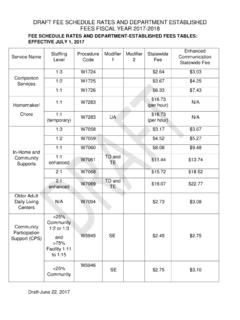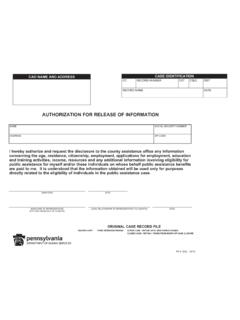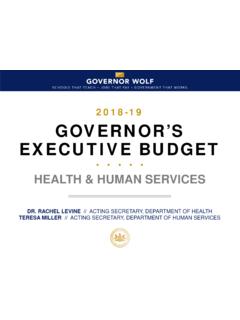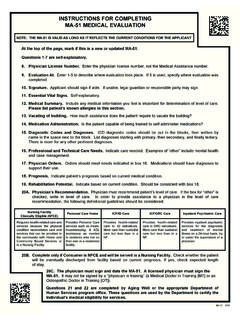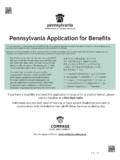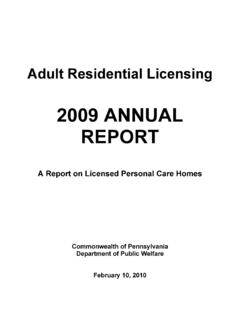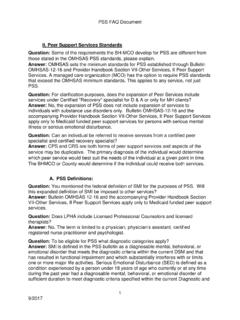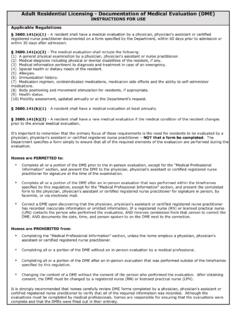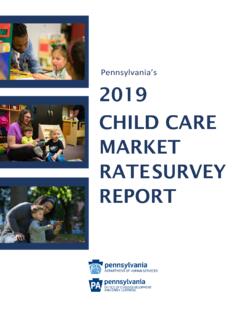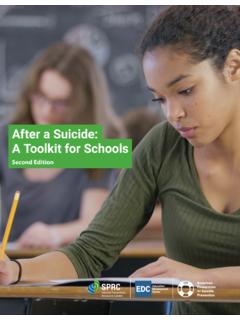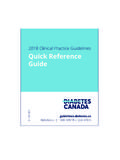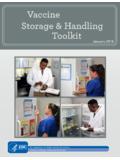Transcription of CENTERS OF EXCELLENCE - Department of Human Services
1 CENTERS OF EXCELLENCE . resource guide . Center of EXCELLENCE resource guide April 2021. TABLE OF CONTENTS. Table Of Contents .. 2. Acronym Definitions .. 8. Introduction to the resource guide .. 9. How to Use the resource Organization Policy/Procedure ..9. CENTERS of EXCELLENCE Mission: Purpose of CENTERS of EXCELLENCE .. 10. Opioid Public Health Crisis .. 10. Organization .. 12. Harm Reduction .. 12. Harm Reduction for Substance Use .. 13. Overdose 13. Safe Use Strategies .. 14. Overdose Reversal .. 14. Syringe Exchange/Access .. 14. Safe Consumption Sites .. 15. Advocacy .. 15. Medical Needs .. 15. Conversation Examples .. 15. ASAM Levels of Care .. 16. The ASAM Explained .. 16. Levels of Care .. 16. Know the Options .. 23. Stages of Change .. 23. Pre-Contemplation .. 24. Contemplation .. 24. Preparation .. 24. Action .. 24. Maintenance .. 24. Recurrence of Use .. 24. Non-Stigmatizing 25. Overview and Definition .. 25. Recommendations for Non-Stigmatizing Language .. 25. Copyright 2021.
2 All Rights Reserved. 2. Staff Roles .. 29. Peer Support .. 31. Case/Care Manager .. 31. Clinical Supervisor .. 32. 32. Provider .. 34. 34. Consent to Release Information .. 35. Disclosures without Patient Consent .. 38. Assessments .. 42. BARC-10 .. 42. Social Determinants of Health .. 43. Referrals .. 43. Documentation .. 45. General Tips .. 45. Service Initiation Assessment .. 46. Treatment Plan .. 46. Progress and Case 48. Electronic Health Records (EHR).. 50. Using Data to Support Quality .. 50. Documenting Incidents and Ethical Matters .. 51. Evidence-Based Practices for Substance Use 53. Assertive Community Treatment (ACT) .. 53. Motivational Interviewing (MI) .. 53. Cognitive Behavioral Therapy (CBT) .. 54. Dialectical Behavior Therapy (DBT) .. 55. Contingency Management (CM) .. 56. Functional Family Therapy (FFT) .. 56. Screening, Brief Intervention, and Referral to Treatment (SBIRT) .. 57. Trauma-Informed Care (TIC) .. 58. Trauma .. 58. Trauma and Substance Use Disorders.
3 63. Trauma-Informed Care .. 64. Copyright 2021. All Rights Reserved. 3. Trauma-Informed Substance Use Disorder Treatment .. 65. Co-Occurring Disorders .. 67. Co-Occurring Disorders .. 67. Common Co-Occurring Mental Health Disorders .. 67. Substance Use Disorder .. 69. Treatment .. 69. Pregnant clients .. 70. Prenatal .. 70. Barriers to Treatment for Pregnant Clients .. 70. Postnatal .. 71. MOUD 71. Criminal Justice-Involved Clients .. 71. Communicating with Probation/Parole Officers .. 71. County Jail-Involved Clients .. 72. Building Rapport with Criminal Justice-Involved Clients .. 72. Treatment Interruptions Incarceration .. 72. 73. Opioids vs. 73. How an Opioid Use Disorder Develops .. 75. Short-Term Health 75. Long-Term Health 75. Tolerance and Withdrawal .. 76. Common Substance Combinations .. 76. Medication for Opioid Use 78. Methadone .. 78. Buprenorphine .. 79. Naltrexone .. 80. Resources .. 81. Adolescents .. 81. ASAM .. 81. Buprenorphine .. 82. Client Engagement and Retention.
4 82. Clinical Supervision .. 82. Copyright 2021. All Rights Reserved. 4. Confidentiality .. 83. Co-Occurring Disorders .. 83. Counseling/Therapy .. 84. Drug Testing .. 84. Enhancing Motivation .. 84. Ethics .. 84. Goals .. 84. Harm Reduction .. 84. Hiring Process .. 85. Levels of Care .. 85. LGBTQIA+.. 86. Mandated Reporting .. 86. Men .. 86. Motivational Interviewing .. 86. Online Support Groups .. 86. Peer Supports .. 87. Pennsylvania Department of Drug and Alcohol Programs (DDAP) .. 87. Pregnant and Parenting Women .. 87. Quality Improvement .. 87. Suicide Concerns .. 88. Trauma-Informed Care .. 88. Twelve Step Programs .. 88. Women .. 89. COE Leadership: Pennsylvania Department of Human Services .. 90. Requirements for CENTERS of EXCELLENCE .. 90. Partnering with Pennsylvania Managed Care Organizations .. 91. 91. Pennsylvania Department of Drug and Alcohol Programs (DDAP) .. 92. Priority 92. Single County Authorities .. 92. Onboarding Staff .. 92. Orientation .. 92. Preparation.
5 92. Copyright 2021. All Rights Reserved. 5. Presentation .. 92. Processing .. 93. Post-Orientation .. 93. Using the resource guide .. 93. Staff Retention .. 94. Clinical Supervision .. 95. Keys to Successful Supervision .. 95. Balancing Clinical and Administrative Responsibilities .. 96. Being Available with Boundaries .. 96. Cultural Competence .. 96. Working Alliance .. 96. Dual 96. Effective 96. Four A's of Supervision .. 97. Motivational Interviewing .. 97. Organizational 97. Supervisory Triad .. 97. Clinical Supervision .. 97. Best Practices .. 98. Common Challenges .. 98. Organizational Health ..100. Vision .. 101. Leadership .. 101. Organizational Behavior .. 101. Organizational 102. Organizational 102. Performance Measurements .. 102. Organizational Learning .. 102. Organizational Health Assessment .. 103. Quality Improvement ..103. Learning Networks .. 103. Using Data to Support Quality .. 103. Using Electronic Health Record (EHR) Data for Growth .. 103. Copyright 2021. All Rights Reserved.
6 6. Potential Challenges .. 108. Managing Changes in Leadership .. 109. Data 109. Building Community Partnerships ..109. References ..112. Appendix 1: Brief Assessment of Recovery Capital (BARC-10) .. 119. Appendix 2: Relevant Contact 120. Appendix 3: Level of Care Options 123. Appendix 4: Stages of Clinical Supervision .. 124. Appendix 5: Innovation 125. Appendix 6: Community Partnership Worksheet .. 126. Appendix 7: Sample Memorandum of Understanding .. 128. Appendix 8: Note Formats .. 130. Appendix 9: Activity Codes List .. 133. Appendix 10: Fentanyl-Related Substances and Non-Prescription Synthetic Opioids .. 142. Copyright 2021. All Rights Reserved. 7. ACRONYM DEFINITIONS. ACNP acute nurse practitioners DHS Pennsylvania Department of Human Services AHRQ Agency for Health Research and Quality EMS emergency medical Services APNP advance practice nurse FQHC Federally Qualified Health CENTERS practitioners IOP intensive outpatient program ASAM American Society of Addiction LCSW Licensed Clinical Social Worker Medicine LOC/LOCA Level of Care/Level of Care BARC-10 Brief Assessment and Recovery Assessment Capital MAT medication-assisted treatment CAAC Certified Associate Addiction Counselor MH mental health CAADC Certified Advanced Alcohol and MI motivational interviewing Drug Counselor MOUD medication for opioid use disorder CADC certified alcohol and drug NATP narcotic treatment program counselor OTP opioid treatment program CCDP Certified Co-Occurring Disorders Professional OUD opioid use disorder CCDPD Certified Co-occurring Disorders PCPC Pennsylvania Client Placement Professional Diplomate Criteria CCJP Certified Criminal Justice PERU Program
7 Evaluation and Research Addictions Professional Unit CBCM care-based care management PHP partial hospitalization CCS certified clinical supervisor PMPM per member per month CDC CENTERS for Disease Control and QI quality improvement prevention SAMHSA Substance Abuse and Mental CMS CENTERS for Medicare and Medicaid Health Services Administration Services SBIRT screening, brief intervention, COE center of EXCELLENCE referral to treatment CRS Certified Recovery Specialist SCA single county authority DDAP Pennsylvania Department of Drug SDOH social determinants of health and Alcohol Programs STI sexually transmitted infection DEA Drug Enforcement Administration SUD substance use disorder Copyright 2021. All Rights Reserved. 8. INTRODUCTION TO THE resource guide . The purpose of this guide is to provide a comprehensive resource for existing and newly designated Pennsylvania Opioid Use Disorder (OUD) CENTERS of EXCELLENCE (COE) sites across the Commonwealth of Pennsylvania. How to Use the resource guide Since 2016, Pennsylvania OUD COE sites have utilized Community-Based Care Management Teams (CBCM) to break down barriers historically associated with attaining recovery for individuals with an Opioid Use Disorder (OUD).
8 This comprehensive guide meets the needs of two staff groupings: COE. leadership and staff. The guide includes a history of the Pennsylvania COEs, expectations of a COE, and the qualifications for a COE-designated organization within a larger system. The staff section provides relevant information from the Pennsylvania Department of Human Services (DHS) and the Pennsylvania Department of Drug and Alcohol Programs (DDAP). The staff section provides information associated with meeting the needs of clients on a day-to-day basis, including documentation requirements and instruments ( , American Society of Addiction Medicine (ASAM) and Brief Assessment of Recovery Capital (BARC-10)) and guidance on how to tailor care for special client populations. The leadership section provides guidance on how to manage a COE to support optimal clinical outcomes using quality improvement (QI) best practices, and how organizational health can be assessed and used to improve staff morale and retention as well as client care quality.
9 Organization Policy/Procedure It is critical for all members of an organization to be highly informed about and skilled in the application of organizational policies and procedures so that clients receive high-quality, standardized ,2. Standardized practices including how staff are on-boarded and receive training, how their roles are specified, and how patient care workflows are defined and followed, create a predictable clinical environment in which clients feel safe to disclose health status and barriers to care they may be experiencing, and staff feel confident about to how they can successfully provide care and address barriers clients reveal. This resource guide presents recommended organizational policy and procedures based on scientific and peer-reviewed the literature and DHS for COEs to guide their staff towards achieving optimal care quality. Note This guide does not supersede individual COEs' or their parent organization's policies. Copyright 2021. All Rights Reserved. 9.
10 CENTERS OF EXCELLENCE MISSION: PURPOSE OF CENTERS OF EXCELLENCE . Opioid Public Health Crisis Opioid Overdose Crisis across the United States Between 1999 and 2011, hydrocodone usage increased by 100 percent, and oxycodone usage increased by 500 Overdose deaths involving opioid substances increased by 300 percent during that same Given these numbers, the United States CENTERS for Disease Control and prevention (CDC) declared the opioid overdose death crisis one of its top five public health threats in The following year, in 2015, the Drug Enforcement Administration (DEA) issued an alert that fentanyl, an opioid that is 50-100 times more potent than morphine, was becoming a rising trend, threatening public health and ,7 Because fentanyl is so potent, it takes very little of the substance to experience a potentially fatal overdose. Some people who use substances are not aware that the substances they consume have been laced with fentanyl because it is a fine white powder that is easy to disguise in mixtures containing other less potent opioids.
